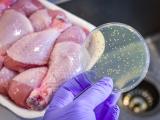Sep 19, 2003 (CIDRAP News) – The US Department of Agriculture (USDA) has found Escherichia coli O157:H7 in fewer ground beef samples this year than in past years, suggesting that a year-old initiative to keep the pathogen out of meat is paying off.
From January through August, 0.32% of samples tested positive for E coli O157:H7, down from 0.78% in 2002 and 0.84% in 2001, the USDA's Food Safety and Inspection Service (FSIS) reported in a news release this week. The FSIS has tested more than 7,000 ground beef samples from grinding plants and retail stores each of the past 2 years.
"The agency's sampling data suggests that initiatives begun in the past year are beginning to pay dividends," FSIS Administrator Garry L. McKee stated. "We are far from satisfied, but the arrow is clearly pointing in the right direction."
In October 2002 the FSIS ordered beef slaughter and grinding plants to review their food safety plans and, unless they could show that E coli contamination was unlikely, take specific measures to control the pathogen. Officials then cited evidence that the pathogen was more prevalent than previously estimated, including data from 2000 showing that 43% of beef carcasses had E coli O157:H7 contamination.
"A majority of the plants have made major changes to their operations based on the directive, including the installation and validation of new technologies specifically designed to combat E. coli O157:H7," the FSIS said this week. "Many plants have also increased their testing for E. coli O157:H7 in order to verify their food safety systems."
FSIS personnel also have been examining the food safety plans and comparing them with what the plants are actually doing, the agency said. In addition, the agency launched new training efforts for inspectors and compliance officers last April.
Craig Hedberg, PhD, a food safety expert at the University of Minnesota, called the USDA figures encouraging. He said industry steps such as treating beef carcasses with steam or organic acid rinses have probably contributed to the improvement. "I don't think we have the data (or ever will) to precisely attribute credit for the decline, but it is encouraging," he commented by e-mail. Hedberg is an associate professor of environmental and occupational health in the university's School of Public Health.
But he said the big question is whether reduced contamination in ground beef is leading to a lower incidence of disease. The latest figures from the Centers for Disease Control and Prevention (CDC) suggest that may be happening: 1,454 cases of E coli O157:H7 were reported through Sep 13 this year, compared with 2,469 through the same week in 2002, according to today's issue of Morbidity and Mortality Weekly Report.
In addition, CDC spokesman Llelwyn Grant said no major multi-state outbreaks of E coli infection related to ground beef have been recognized this summer, whereas several have been reported the past few summers.
The FSIS samples ground beef at grinding plants and retail stores that do their own grinding and also tests imported ground beef. Testing for E coli O157:H7 began in 1994. The first several years of monitoring showed very low rates of contamination, but higher levels were found after a more sensitive test was adopted in 1999, according to charts on the FSIS Web site. The rate climbed from 0.17% in 1998 to 0.41% in 1999 and 0.86% in 2000.
USDA data compiled by Hedberg show that slightly more than 1% of ground beef samples from retail stores had E coli O157:H7 contamination in 2002. No separate figures on retail ground beef were available for 2003.
See also:
FSIS news release
http://www.fsis.usda.gov/oa/news/2003/gbsample.htm
FSIS E coli test results from 1994 through 2002
http://www.fsis.usda.gov/OPHS/ecoltest/tables1.htm
MMWR tally of notifiable diseases, including E coli infections, so far this year
http://www.cdc.gov/mmwr/preview/mmwrhtml/mm5237md.htm#tab2
Sep 23, 2002, CDRAP News story on FSIS plans to reduce E coli contamination in beef
















